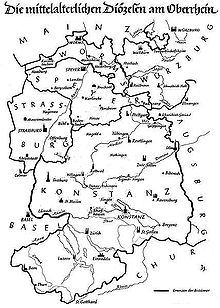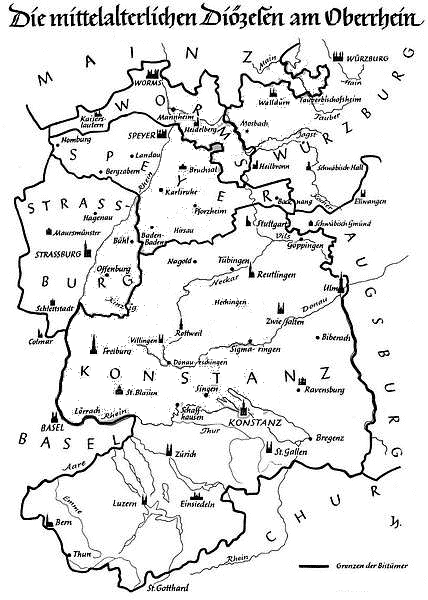Bishopric of Constance
The diocese of Constance, headquartered in Constance consisted of about 585 until its dissolution in 1821. Belonging to Germany areas went up in the newly founded bishoprics Freiburg and Rottenburg, belonging to Switzerland areas were the dioceses of Chur and Basel subordinate to the administration. The diocese was part of the so-called Pfaffengasse and the core area of the duchy of Swabia.
Diocesan area
At the end of the Salian dynasty in the 12th century the Holy Roman Empire consisted of 42 dioceses in the Church six provinces. The size of the German dioceses exceeded with an average of 13,000 km2 by far the remaining dioceses. The largest dioceses were in the 12th century Prague ( 52,000 km2 ), Salzburg ( 40,000 km2) and Constance ( 36,000 km2).
At the peak of the diocese of Constance in the 15th century ( modern times) it was definitely the largest German diocese, only in the Middle Ages it was surpassed by Passau. With approximately 45,000 km2 it was bigger than today's Switzerland with 41,300 km2, or the state of Baden -Württemberg with 35,750 km2. By area, the dioceses of Passau and Constance were approximately the same size, but was of Constance by twice surpassed in terms parishes, clergy and the " take care of souls." In the year 1249 there were in the diocese of Passau about 920 parishes in Constance in 1439, over 1,700 parishes.
The Konstanz diocesan territory, belonging to the ecclesiastical province of Mainz, covering mainly the Gotthard massif to the upper Danube, the upper and middle Neckar, from the Rhine to the Iller and included the Breisgau and the Bregenz Forest and the area of the east of the river Aare North, central and eastern Switzerland. The diocese was (from 1275 ) is divided into 64 deaneries and ten Archidiakonate: Black Forest, rough Alb, Allgaeu, Illergau, Burgundy, Unterklettgau, Breisgau, Thurgau, Zürichgau, Aargau. The so-called " Swiss quart " of the diocese of Constance comprised large parts of present-day Switzerland, as the greater part of the canton of Aargau, the areas of the cantons of Berne and Solothurn right of the Aare, the cantons of Uri, Schwyz and Obwalden and Nidwalden and almost completely the cantons of Lucerne, train, Glarus, Zurich, Schaffhausen, Thurgau, St. Gallen and the two Appenzell cantons. From the Canton of Basel, only the right bank part of the town of Basel was part of the diocesan territory.
History
First missionaries on Lake Constance
The first missionaries monks Fridolin, Landolin Trudpert and Gallus came in the 6th century to the Alemanni on the Rhine and Lake Constance. Säckingen on the Upper Rhine and mucking in Ortenau are the earliest monastic foundations. This includes the monastery island of Reichenau on the Lake of Constance, which has founded around 724, the itinerant bishop Pirmin. Other monasteries that do not last very soon were identified by their schools as centers of Christian life, originated in Gengenbach, Schwarzach, Mosbach and Ettenheimmünster.
Also in the 7th and 8th centuries, Christianity appeared in the Main-Franconian territories. There were in particular the Holy Kilian and Saint Boniface with their helpers who prepared the ground for the church. A great charisma won in that time, the Benedictine monastery in Tauberbischofsheim by the Holy Leoba, who headed it since about 750 as abbess.
Alemanni diocese
To evangelize the Alemanni, was in the 6th century, probably founded in 585 the diocese of Constance by the bishopric of Vindonissa ( Windisch ) was transferred to Constance. By the year 780/782 the diocese belonged to the ecclesiastical province of Besançon, from this point to the ecclesiastical province of Mainz.
Among the most prominent bishops of the early Middle Ages was one of the " Alemanni Bishop " Konrad of Constance ( term 934-975 ).
In the 7th century a bishop's church is mentioned for the first time. With the construction of the Cathedral of Our Lady is started in 1054 after the Ottonian previous church had collapsed.
As in the 11th century, the Abbey of Cluny in Burgundy to starting point and focus of a radical reform of the monastic life was the renewal movement of the Cluniac from Hirsau of spread in the southwest of Germany and led, among others, to the founding of the monastery of St. Peter in the Black Forest, in the seminary of the Archdiocese of Freiburg is housed. In the wake of the second, more radical reform movement of the Cistercians in the 12th century, among others, the influential imperial abbey of Salem, the monastery and the monastery Tennenbach light Thal emerged.
Council of Constance
The center of the ecclesiastical and political events moved the beginning of the 15th century, the then Bishop city of Constance, as there was held from 1414 to 1418 the Council of Constance. It was convened by Emperor Sigismund to clarify the controversial question of the rightful pope after the return of the popes from Avignon. The choice fell to Cardinal Colonna, who called himself as Pope Martin V.. The church bishops were secular lords of the Prince-Bishopric of Constance.
Reformation and Counter-Reformation
The in the first half of the 16th century dawning with Martin Luther Reformation spread very quickly in the southwest of Germany. The Margrave of Baden- Durlach, who lived in Heidelberg Elector Palatine among the most important rulers who introduced the Reformation in their areas. Constance was reformed in 1527; the bishop fled to Meersburg.
However, Constance remained unreformed for long: in 1548 forced the Habsburgs to the city recatholicization. She was relieved of its status as a free city and have been incorporated into western Austria. Although the bishop officially returned to Constance, but his residence remained until the end of the diocese in Meersburg. By 1600, it was above all the Jesuits, who were brought to Constance, for the resurgence of the Catholic faith.
Secularization and resolution
The rationalist mind flow from the second half of the 18th century and funded primarily by Emperor Franz Joseph II enlightened absolutism had on the front belonging to Austria Fribourg into southwestern Germany. A up to now affecting ligand fundamental change brought the Napoleonic wars and the secularization of 1803. Had the political reorganization in the southwest of Germany, a reorganization of the rich ecclesiastical territories result. The Bishopric of Constance fell under § 5 of the Reichsdeputationshauptschluss circuit ( RDH ) with its ratification (April 27, 1803) at the Margraviate of Baden; already by patent dated 16 September 1802, the Margrave of Baden had taken the diocese temporarily in possession.
The ecclesiastical parish of the diocese remained of the constitutional reorganization initially unaffected (§ 62 RDH ). However, only limited was the exercise of ecclesiastical government powers in Baden Württemberg and by the desire of governments, a sort of " national magnificent church government " also about the Catholic Church to build ( in the ministries of education institution " Catholic departments " ) is possible; especially in Württemberg, the remaining ecclesiastical powers of the diocesan bishop of Constance have been limited to the inherent violence of the ordination tasks.
In Constance worked within the meaning of Enlightenment Josephinism especially the Vicar General Ignaz Heinrich von Wessenberg under Bishop Karl Theodor von Dalberg. After Dalberg's death in 1817 the cathedral chapter of Wessenberg chose as his successor. Pope Pius VII refused to recognize the election. The bull Provida solersque from August 16, 1821 declared the Diocese of Constance resolved. It should (now Rottenburg- Stuttgart) rise in the newly founded bishoprics Archdiocese of Freiburg and Rottenburg. The Swiss part of the diocese of Constance were first provisionally administered by the Abbot of Beromunster and the bishoprics of Basel and Chur diocese assumed. Wessenberg exercised his office under the protection of the Baden rulers until 1827, as the Nachfolgebistümer Freiburg and Rottenburg could be after a long political struggle between Baden and the Vatican occupied until 1828.
How about crashing the largest diocese of the Roman Catholic Church has been resolved beyond the Alps to get rid Wessenberg shown by the fact that the Swiss cantons of Glarus, Obwalden and Nidwalden, Uri and Zurich to the present day as territories of the former diocese of Constance be provisionally administratively managed by the Bishop of Chur. The canton of Thurgau came to the diocese of Basel, Canton of St. Gallen forms since 1823/47, the diocese of St. Gallen, the two half-cantons of Appenzell are assumed to be apostolic administration.
The diocese was very enlightened at the end of its existence, and liberal; 50 years after its dissolution or formed resistance to the First Vatican Council. In the diocese of Constance, there is still the heartland of the Old Catholic and Christian Catholic Church in Germany and Switzerland. Many hymns and traditions in today's Roman Catholic dioceses of Freiburg, Rottenburg -Stuttgart, Chur and St. Gallen are from the heyday under Bishop Dalberg and episcopal Wessenberg.










